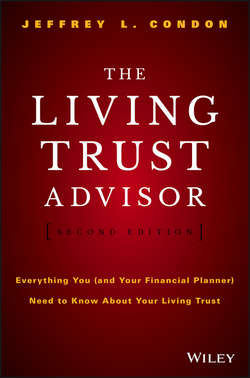Читать книгу The Living Trust Advisor - Condon Jeffrey L. - Страница 17
На сайте Литреса книга снята с продажи.
The First Quarter
Establishing Your Living Trust
CHAPTER 3
Do You Really Need a Living Trust?
Or, Don’t Let Someone Sell You Something You Don’t Need
So, What’s Not to Like?
ОглавлениеIt sounds like having a Living Trust, as opposed to a will, is a no-brainer. I agree. Use a will – go to probate. Use a Living Trust – avoid probate and save thousands of dollars for your family. But still, you may believe you need a Living Trust when, in fact, you really could do without.
My basic rule about whether you need a Living Trust is this: If you own real estate of any value, whether $10,000 or $10 million, you need a Living Trust. It’s that simple. If you own any real estate, you should establish your Living Trust and transfer title of your real estate to yourself as trustee of your Living Trust. This vesting is accomplished with a deed, which will read as follows:
Grantor:
Mr. and Mrs. Bookbuyer, Husband and Wife
Hereby transfers, conveys, and quitclaims to:
Grantee:
Mr. and Mrs. Bookbuyer, Trustees of the Bookbuyer Living Trust
When both of you have died, the person or persons you appoint as your successor trustee – probably your children – will transfer the property to the persons whom you have named in your Living Trust as the beneficiaries of your house. No mess. No fuss. No muss.
If you do not own real estate, and your estate consists of, say, cash or brokerage assets, you could prevent those assets from going through probate after your death, and without the Living Trust, by simply revesting the accounts so that they are “pay over on death” accounts. These are accounts that keep the cash or stock in your name during your lifetime and, on your death, are automatically transferred (without probate) to the persons whom you have named as beneficiaries on the account.
In order to establish this type of account, you have to schlep to your bank or brokerage house and tell the account representative, “I want to change my account so that it becomes a ‘pay over on death’ account like Mr. Condon said in his amazing Living Trust book.” The representative will then have you complete some paperwork in which you name the people whom you want to receive the account after you die. For example, if you want your daughter to be the beneficiary of that account, the account will then be vested as: Mr. and Mrs. Bookbuyer ATF the Bookbuyers’ Daughter.” The term ATF means “as trustee for,” which expressly states that you are now holding the account as trustees for your daughter.
The “pay over on death” account is kind of like establishing a separate Living Trust for that asset. I say “kind of” because there is no separate inheritance instrument for that account other than the account itself. But during your lifetime, you have complete control and ownership of the account as if it were in a Living Trust, and your daughter has no access to that account during your lifetime. When you die, your daughter takes over the account as if she were the successor trustee and transfers it to herself as the beneficiary.
Financial Advisor Alert
If your client sets up this “pay over on death” account and the beneficiary dies before your client, then the account becomes a probate asset and must undergo the probate processes. Instruct your client that if the beneficiary dies during your client’s life, the client must either (a) transfer the account to the Living Trust or (b) name a new beneficiary on that account.
This sounds like a pretty good arrangement. So you think, “I will just perform the ‘pay over on death’ arrangement on my house and prevent it from going through probate. Why do I need an expensive Living Trust to avoid probate on my house when I can just put it in the ‘pay over on death’ format?”
I will tell you why! Because that method of holding title to real estate does not exist in the United States. There is no form of real estate ownership in which you can put real property in an “ATF” manner and still have the full use of your house while you are alive.
There is, however, one method of holding title to real estate in which you can avoid probate of your house without a Living Trust: joint ownership. As you are reading this very sentence, you have the perfect legal right to put your children on title to your house as joint tenants. When you die, your share of the house will automatically transfer to your children (with the preparation and recording of a document that states that you, a co-joint tenant, have died). It is as simple as that.
There! Like a magician who has disclosed the secret of an ancient illusion, I have told you how to beat the system. Actually, I am probably not revealing anything new to you, so I don’t have to worry about my colleagues hunting me down for disclosing a trade secret that can cost them some fees. Most likely, you hold title to your house jointly with your spouse. It is a logical extension to consider putting your children’s names on the title as well – especially if that trick can prevent your assets from being diminished by the probate process after you die.
So, if you can prevent your house from going through probate after your death by putting your children’s names on the deed, why have a Living Trust at all? Why not just use that device and forget the Living Trust altogether? The answer is hinted at in the next heading.
